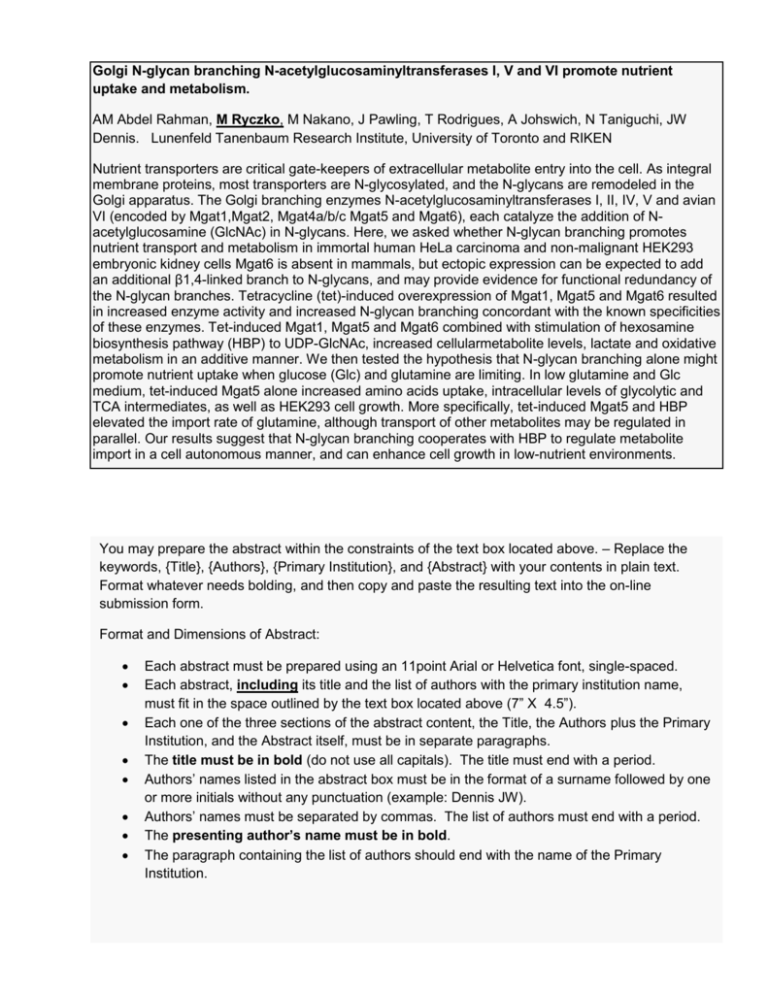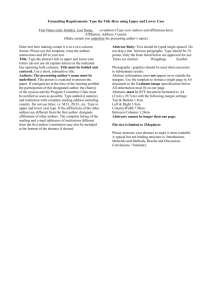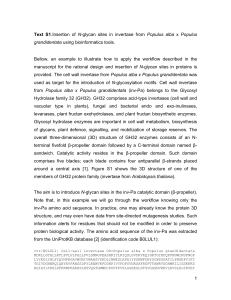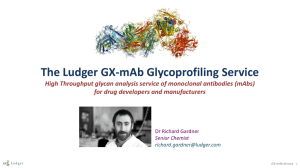Here is also an example of a populated template ready for copying
advertisement

Golgi N-glycan branching N-acetylglucosaminyltransferases I, V and VI promote nutrient
uptake and metabolism.
AM Abdel Rahman, M Ryczko, M Nakano, J Pawling, T Rodrigues, A Johswich, N Taniguchi, JW
Dennis. Lunenfeld Tanenbaum Research Institute, University of Toronto and RIKEN
Nutrient transporters are critical gate-keepers of extracellular metabolite entry into the cell. As integral
membrane proteins, most transporters are N-glycosylated, and the N-glycans are remodeled in the
Golgi apparatus. The Golgi branching enzymes N-acetylglucosaminyltransferases I, II, IV, V and avian
VI (encoded by Mgat1,Mgat2, Mgat4a/b/c Mgat5 and Mgat6), each catalyze the addition of Nacetylglucosamine (GlcNAc) in N-glycans. Here, we asked whether N-glycan branching promotes
nutrient transport and metabolism in immortal human HeLa carcinoma and non-malignant HEK293
embryonic kidney cells Mgat6 is absent in mammals, but ectopic expression can be expected to add
an additional β1,4-linked branch to N-glycans, and may provide evidence for functional redundancy of
the N-glycan branches. Tetracycline (tet)-induced overexpression of Mgat1, Mgat5 and Mgat6 resulted
in increased enzyme activity and increased N-glycan branching concordant with the known specificities
of these enzymes. Tet-induced Mgat1, Mgat5 and Mgat6 combined with stimulation of hexosamine
biosynthesis pathway (HBP) to UDP-GlcNAc, increased cellularmetabolite levels, lactate and oxidative
metabolism in an additive manner. We then tested the hypothesis that N-glycan branching alone might
promote nutrient uptake when glucose (Glc) and glutamine are limiting. In low glutamine and Glc
medium, tet-induced Mgat5 alone increased amino acids uptake, intracellular levels of glycolytic and
TCA intermediates, as well as HEK293 cell growth. More specifically, tet-induced Mgat5 and HBP
elevated the import rate of glutamine, although transport of other metabolites may be regulated in
parallel. Our results suggest that N-glycan branching cooperates with HBP to regulate metabolite
import in a cell autonomous manner, and can enhance cell growth in low-nutrient environments.
You may prepare the abstract within the constraints of the text box located above. – Replace the
keywords, {Title}, {Authors}, {Primary Institution}, and {Abstract} with your contents in plain text.
Format whatever needs bolding, and then copy and paste the resulting text into the on-line
submission form.
Format and Dimensions of Abstract:
Each abstract must be prepared using an 11point Arial or Helvetica font, single-spaced.
Each abstract, including its title and the list of authors with the primary institution name,
must fit in the space outlined by the text box located above (7” X 4.5”).
Each one of the three sections of the abstract content, the Title, the Authors plus the Primary
Institution, and the Abstract itself, must be in separate paragraphs.
The title must be in bold (do not use all capitals). The title must end with a period.
Authors’ names listed in the abstract box must be in the format of a surname followed by one
or more initials without any punctuation (example: Dennis JW).
Authors’ names must be separated by commas. The list of authors must end with a period.
The presenting author’s name must be in bold.
The paragraph containing the list of authors should end with the name of the Primary
Institution.







